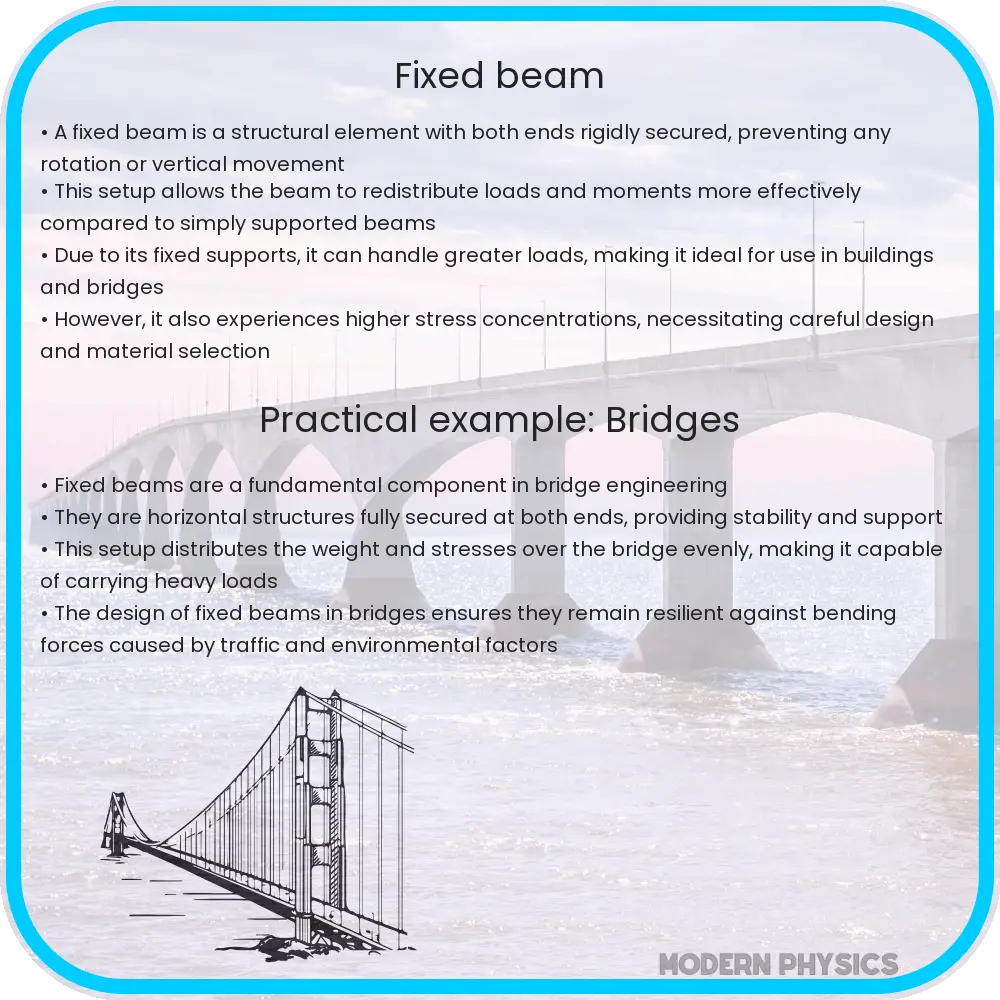Explore the essentials of fixed beam analysis in structural engineering, covering strength, stiffness, support reactions, and real-world applications.

Understanding Fixed Beam Analysis: Strength, Stiffness, and Support
Fixed beams are a fundamental component in structural engineering, offering unique advantages in terms of strength, stiffness, and support. These beams are characterized by their fixed ends, which restrict both rotational and translational movement. This article delves into the key aspects of fixed beam analysis, essential for anyone involved in structural design and engineering.
Strength of Fixed Beams
One of the primary attributes of fixed beams is their enhanced strength compared to simply supported beams. The fixed ends provide greater resistance to bending moments, making them ideal for supporting heavy loads. This is crucial in applications such as bridge construction, building frameworks, and overhanging structures. The strength of a fixed beam can be calculated using the formula:
M = \frac{F \times L}{8}
Where M is the maximum bending moment, F is the load, and L is the length of the beam.
Stiffness of Fixed Beams
The stiffness of a beam relates to its ability to resist deformation under load. Fixed beams exhibit higher stiffness due to their fixed boundary conditions. This results in less deflection under the same load compared to other types of beams. The deflection of a fixed beam is given by:
\delta = \frac{5F \times L3}{384 \times EI}
In this equation, \delta represents deflection, E is the modulus of elasticity, I is the moment of inertia, and F and L have the same meanings as above.
Support Reactions in Fixed Beams
Understanding the support reactions in fixed beams is crucial for accurate structural analysis. Unlike simply supported beams, fixed beams have moments and shear forces at the supports due to the fixed ends. The support reactions can be calculated using equilibrium equations, considering the sum of forces and moments around the supports. These calculations are vital for ensuring the structural integrity and safety of the construction.
This introduction provides a basic understanding of the strength, stiffness, and support mechanisms in fixed beam analysis. The next section will explore advanced topics, including load distribution, real-world applications, and design considerations.
Advanced Aspects of Fixed Beam Analysis
Delving deeper into fixed beam analysis, it’s important to consider factors like load distribution and real-world applications. The way a load is applied to a beam significantly affects its response. In engineering practice, loads can be uniform, concentrated, or varying. Each type of load distribution has a unique impact on the internal forces and moments in a fixed beam.
Real-world Applications of Fixed Beams
Fixed beams are extensively used in various structures, such as bridges, overpasses, and building frameworks. Their ability to carry heavier loads and resist larger moments makes them ideal for these applications. In bridge construction, for example, fixed beams can span longer distances without the need for intermediate supports, making them a preferred choice for long-span bridges.
Design Considerations in Fixed Beam Analysis
Designing fixed beams requires careful consideration of factors like material properties, beam geometry, and load characteristics. The choice of material, whether steel, concrete, or timber, affects the beam’s strength and stiffness. Beam geometry, including cross-sectional shape and size, also plays a critical role in determining the beam’s load-bearing capacity and deflection characteristics.
Furthermore, safety factors are integral to the design process, ensuring that the beam can withstand unexpected loads or stressors. Engineers must also comply with relevant building codes and standards, which dictate minimum design requirements for safety and performance.
Conclusion
Fixed beam analysis is a crucial aspect of structural engineering, offering enhanced strength, stiffness, and support compared to other beam types. Understanding the nuances of fixed beam analysis, from load distribution to design considerations, is essential for engineers and architects. These beams play a pivotal role in modern construction, enabling the creation of durable, reliable, and efficient structures. As engineering technology advances, the application of fixed beams will continue to evolve, further solidifying their importance in the construction industry.
